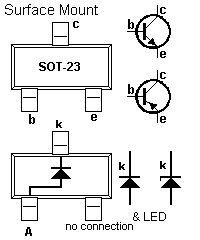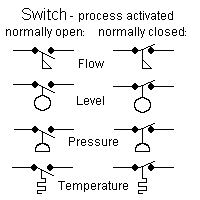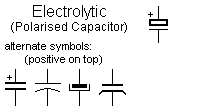10. Other components
The following table covers almost every circuit symbol
you will need. This is the English/American version of each symbol. The
European version of some symbols is slightly different and are shown
further down the page.
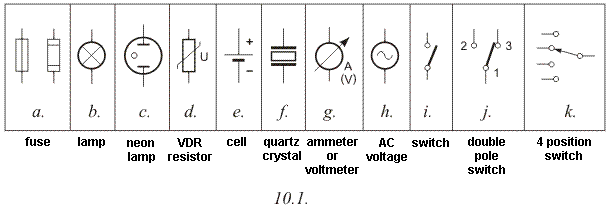
NOTES
Here are a few notes on the symbols above.
Fuses (10.1a) have single role in a circuit - to
detect excess current and protect the device. In most cases the excess
current flows when a higher voltage is present but a fuse cannot detect
the voltage - it can only detect when a higher current flows. The higher
voltage causes the higher current to flow and this triggers the action
of "blowing the fuse." Of course, when a component fails, a
higher current can flow and this will also "blow the fuse."
Fuses come in all sizes and ratings (current flow) and it is important
to know that the size of the wire inside a fuse does not necessarily
indicate the current rating.
The wire inside can be made from copper and plated to protect it from
oxidizing or it can be a low temperature material that needs to be a
larger diameter.
The wire can also be wound in a spiral and formed into a spring. The end
of the spring sits in a dob of solder and when the spring heats up, the
solder melts and the spring separates from the other end.
This is called a DELAY FUSE.
Other forms of delay fuse consist of a wire joined at the centre by a
dob of solder and others are made of low-temperature-melting material.
Some pieces of equipment use expensive fuses and whenever a fuse is
damaged, you must decide if the problem is a major or minor fault.
Sometimes a fuse can go open-circuit for no apparent reason. It can
"wear-out."
For instance, some equipment takes a very high current when it is turned
on and you will see the fuse heat up and stretch and dip in the middle.
This causes strain on the fuse and eventually the wire oxidizes to a
point where it finally "burns out."
The equipment is not faulty and it is just a matter of replacing the
fuse.
Sometimes the fuse completely explodes and the glass is thrown all over
the chassis. This indicates a short-circuit in the power supply and most
often one or more of the diodes must be replaced.
The fuse can also go off with a "bang" and the inside of the glass is
coated with "silver." This also indicates a diode is damaged in the
power supply. Generally 2 or 4 diodes are damaged.
If the fuse is damaged beyond recognition, you will not know if it is a
delay fuse or a normal fuse.
The current-rating on the end-cap can sometimes help you.
For instance, if a fuse is rated at 4A, you will need to replace it with
a 4 amp normal fuse or 3.15 amp slow-blow.
When fuses are rating at 100mA to 250mA, they are very delicate and will
not accept the slightest overload.
When replacing this type of fuse, it is necessary to determine if the
equipment is drawing a heavy current when turning on or if a fault
exists in the power supply. Sometimes the switch can cause the problem
if it is not making contact fast enough.
Replace the fuse and watch it as someone else turns on the equipment. If
the fuse burns out immediately, a short exists. If the fuse glows red
and burns out, the equipment is drawing too much current during turn-on.
This may be due to devices you have added to the equipment or operation
on a slightly higher voltage. You can try a fuse with a slightly higher
rating to see if the fault is fixed.
Never replace a 100mA fuse with a 1 amp fuse. The 1 amp fuse will never
"blow" and if the transformer is being overloaded, the
transformer will simply
"cook."
Lamps (10.1b) Ordinary electric light
globes heat a coil of tungsten wire inside a glass bulb that has an
inert gas such as argon. The resistance of the filament depends on the temperature it is
heated to. It can be ten to twenty
times higher than when it is cold.
A neon lamp (10.1c) contains a gas (such as neon) and this gas gives off
a glow when a high voltage is applied to two plates. This glow occurs at
about 70v to 90v and a resistor must be used in series to prevent the
voltage rising higher than required by the lamp. To put this more
accurately, the resistance of the neon lamp reduces when it "strikes"
and a high current will flow. To limit this current a "current limit"
resistor is needed.
VDR (10.1d) The resistance of a VDR
depends on the voltage across it. A VDR is also called a VARISTOR. Its
resistance is high until a critical value of voltage and the resistance
suddenly drops. They are used as voltage protection devices. If
they, for example, see a voltage higher than 220V, their
resistance decreases and this “soaks” the excess voltage. Their response
time is only a few 10's of nanoseconds.
The symbol for a single DC
cell is shown in 10.1e.
A Quartz crystal is shown in 10.1f.
It is a thin sheet of quarts material between two metal plates
and packaged in a metal case. Quartz crystals are commonly used as the
reference for an oscillator circuit, such as a clock source in
microprocessor designs.
An instrument for measuring current (A) and voltage (V)
is shown in 10.1g. This symbol dates from the time when analog instruments with
a
needle were used. The symbol remains the same, although digital
instruments have replaced analog devices.
AC voltage symbol
is shown in 10.1h. The shape of the wave is shown in the symbol. It can be
sine-wave or saw-tooth or square-wave.
The simplest form of
switch device is displayed in 10.1i. Because of the wide range of switches,
there are many different types in use. For example, a two pole switch
(10.1j) has two operating positions, in one position it connects points 1
and 2, and in the other it connects points 1 and 3.
There are switches
with more operating positions. 10.1k is an example of a rotary switch with four positions.
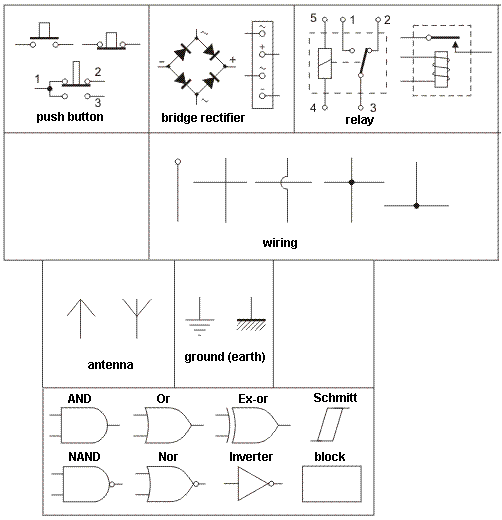
Momentary switches, or push
buttons have a built-in spring, which makes the switch conduct only
while it is being pressed (your standard doorbell has this kind of
switch).
Four diodes in a single case
is called a BRIDGE. Two pins are marked with sine waves, used to connect
to the
AC voltage and two marked with "+" and "-"
RELAY When an electromagnet receives sufficient voltage on points 4 and
5, connection between points 2 and 3 is opened, and at the same time
points 3 and 1 are closed. A relay is actually an electromagnetic switch.
Symbols for a receiving and transmitting antenna are shown.
Grounding symbols Grounding and common
ground aren't the same thing, but if both exist in a circuit, they are
always connected to each other. With electronic devices housed in a
metal case, grounding is connected to the metal housing.
Schematic
symbols representing logic gates and different digital integrated
circuits are shown above. It should be kept in mind that basic logic
gates (AND, OR, XOR, Inverter, etc.) aren't manufactured as single
standalone components. They are always integrated in groups in an IC,
but for the sake of clarity, they are represented as separate blocks.
These components require a DC voltage, which may or may not be
represented on the schematic. These voltages might be different
depending on the internal structure and technology used between
different family types. Detailed info on this can be found in the
component's datasheet provided by the manufacturer.
10.1
Relays
A relay is an electro mechanical device which is commonly
used to connect two different circuits. It can connect a low voltage
circuit to a high voltage circuit or a low current circuit to a high
current circuit or simply to isolate two circuits.
The simplest relay has one set of contacts (commonly called
"change-over" contacts). Inside the relay is a coil (called a solenoid)
and when the coil is energised, the centre core of the solenoid becomes
magnetised and moves an arm closer to the coil. A "contact" is connected
to this arm and the contact touches another contact to complete a
circuit. The contacts are labeled "common" for the moving contact,
"normally open" and "normally closed." This can be seen in
diagram 10.2 a:
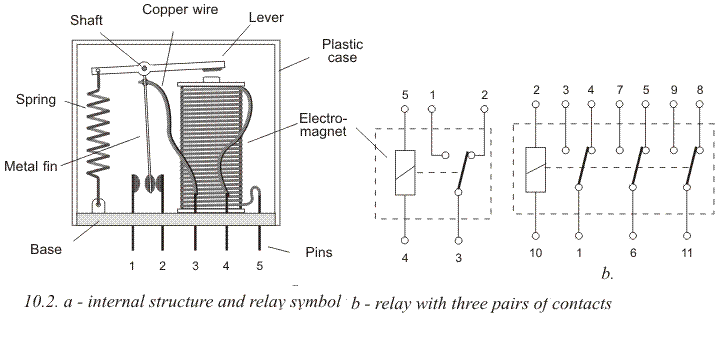
A relay can be connected as the collector load of a transistor, as shown on 10.3.
When sufficient collector current flows in the transistor, the relay is
activated and any device connected to the contacts will be operational.
Since a relay is an electro mechanic component
which is consisted of moving parts, it has a limited operational life
span, and cannot be used for rapid switching. It would not be very
effective using it in a, for example, light show which has frequent
switching frequency (several hundreds or thousands times per hour). Each
opening and closing of the contact is followed by sparks which would
dramatically shorten the life of such device.
Coil values are “input values” or voltage and
resistance values at which relay draws the lever and switches. Usual
coil voltages are 3V, 5V, 6V, 12V and 24V. They can be found
printed on the relay's housing. These are all DC voltages, but there
are AC voltage designed relays with 230V/250V. The current taken by
the relay depends on the resistance of the coil. The coil resistance
can be measured with a multimeter.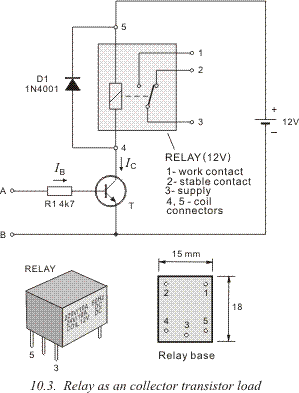 Current
flowing through the coil is calculated using Ohm's law, by dividing
the relay's voltage by its resistance. For example a 12v relay has a
coil resistance of 300 Ohm,
which means the current flow is: Current
flowing through the coil is calculated using Ohm's law, by dividing
the relay's voltage by its resistance. For example a 12v relay has a
coil resistance of 300 Ohm,
which means the current flow is:
I=U/R=12/300=40mA.
2. Voltage on relay's contacts, also
marked on the housing, is the maximum value allowed. Over-voltage will cause sparks
inside the relay and possibly damage the contacts.
The maximum current rating for a relay is marked on
the housing with all the other information. It is usually higher than 1A.
|
 Current
flowing through the coil is calculated using Ohm's law, by dividing
the relay's voltage by its resistance. For example a 12v relay has a
coil resistance of 300 Ohm,
which means the current flow is:
Current
flowing through the coil is calculated using Ohm's law, by dividing
the relay's voltage by its resistance. For example a 12v relay has a
coil resistance of 300 Ohm,
which means the current flow is:









